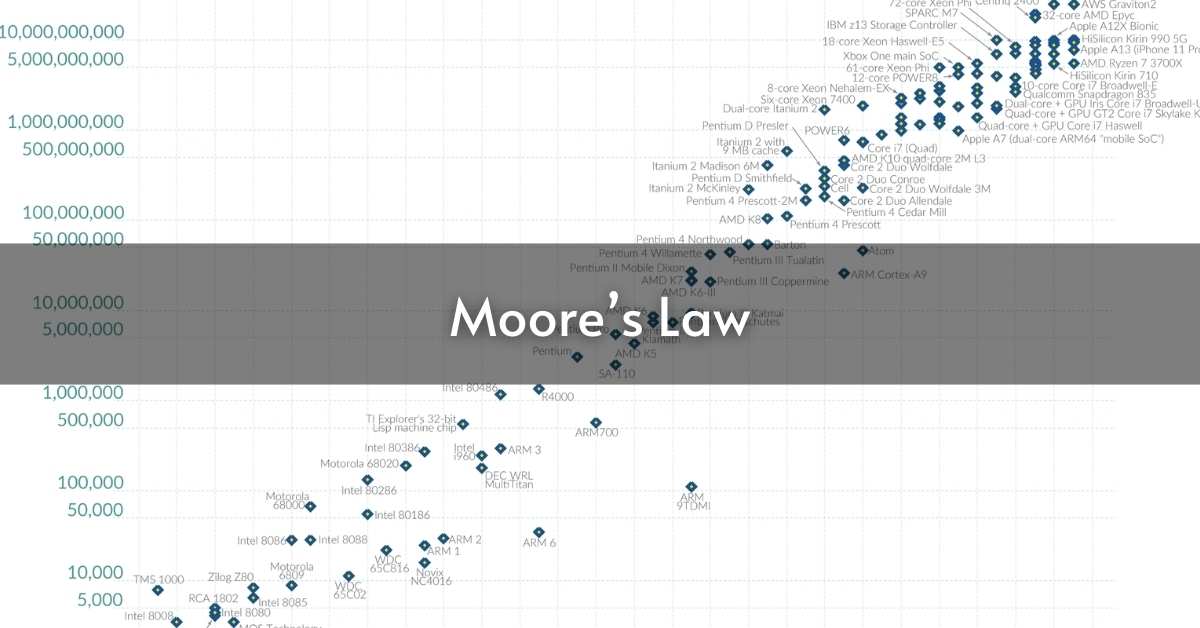Moore’s Law isn’t a legal law or a proven scientific theory like E = mc². Instead, it’s an observation made by Gordon Moore in 1965 while he worked at Fairchild Semiconductor. He noticed that the number of transistors on a microchip doubled about every year. Moore later co-founded Intel Corporation, and his observation became a key factor in the growth of semiconductor technology at Intel and beyond. In this guide, we will explain Moore’s Law and look at what it means for the future.
What is Moore’s Law?
Moore’s Law says that the number of parts on a single chip doubles every two years for a low cost. Although it is not a scientific law, it is an observation that has remained true since 1965.
Gordon Moore published his observations that became known as Moore’s Law in a 1965 article for Electronics Magazine while working at Fairchild Semiconductor. You can see an original draft of that article here.
The Computer History Museum in Mountain View, California, explains that Carver Mead, a professor at the California Institute of Technology (Caltech), first coined the term “Moore’s Law” around 1975. Professor Mead is now the Gordon and Betty Moore Professor Emeritus of Engineering and Applied Science at Caltech, where he has taught for over 40 years. His early work helped create advanced semiconductor designs that relied on the predictions of the Law.
How Does Moore’s Law Work?
Moore’s Law comes from observations made by Gordon Moore. He noticed that the number of transistors on a microchip doubles every year based on data he saw.
As time passed, people adjusted the details of Moore’s Law to better match how transistors actually grew in density. First, they changed the doubling time to two years, and then to about 18 months. Despite these changes, the exponential growth in Moore’s Law continued, providing many opportunities for the semiconductor industry over the decades.
The Benefits of Moore’s Law
Semiconductor process technology has always become more complex. This complexity drives Moore’s Law forward. Recently, this increase in complexity has sped up. Transistors now have a three-dimensional structure and show surprising behaviors. The tiny size of features in advanced technologies requires multiple exposures (called multi-patterning) to create these features accurately on a silicon wafer. This step adds a lot of complexity to the design process.
All this complexity has slowed down the law. While moving to a new process node is still possible, the high complexity and cost of this change have made it slower. Each new process node also shows less significant improvements in density, performance, and power reduction. Semiconductor process technology is approaching its molecular limits, which slows down the exponential benefits of the Law.
Special Considerations
The idea of a future where everyone is empowered and connected brings both challenges and benefits. For over fifty years, smaller transistors have driven progress in computing, but engineers and scientists need to find new ways to make computers better soon. Instead of focusing on physical processes, applications and software can help increase the speed and efficiency of computers. Cloud computing, wireless communication, the Internet of Things (IoT), and quantum physics may all contribute to future computer technology advancements.
Even though there are growing worries about privacy and security, smarter computing technology can help us stay healthier, safer, and more productive in the long run.
Is Moore’s Law Finally Ending?
No, this is not true. It still brings significant improvements, but these improvements happen more slowly now. The speed of technology innovation is not decreasing. In fact, the rise of hyper connectivity, big data, and artificial intelligence has sped up innovation and created a greater need for improvements like those seen in this law.
For many years, the complexity of scaling technology and the fast growth of the semiconductor industry. Now, as it becomes harder to scale a single chip, the industry is looking for new ways to innovate. This effort will help maintain growth and ensure that technology continues to advance and meet future demands.
Conclusion
Moore’s Law started as a simple observation by Gordon Moore in 1965. He noticed that the number of components on a microchip seemed to double every year. He thought that by 1975, an integrated circuit could have 65,000 components. In 1975, he changed his prediction, saying the number of components would double every two years instead. This idea stayed mostly true for about 50 years. In 2024, engineers and scientists continue to work hard to keep up with this trend, and they have even managed to print transistors nearly the size of atoms.
FAQs
What is Moore’s Law in simple terms?
Moore’s Law says that the number of transistors on a computer chip will double every two years without a big increase in cost. Gordon Moore, one of the founders of Intel, made this prediction in 1965.
Is Moore’s Law still true?
In 1975, Gordon Moore updated his prediction to say that components would double every two years. This idea stayed mostly true for about 50 years. In 2024, engineers and scientists still work hard to keep this going, and they have made transistors nearly the size of atoms.
Who proposed Moore’s Law?
Moore’s Law isn’t a natural law; it’s an observation about a long-term trend in technology. Gordon E. Moore, co-founder of Intel, first described it in 1965. The chart shows the original graph he drew to explain this trend.
How has Moore’s Law impacted computing?
The law has helped shape the growth of computing power by giving chip makers a goal. In 1965, Moore predicted that chips would have 65,000 transistors by 1975.
Is Moore’s Law coming to an end?
As components keep getting smaller, we will reach physical limits this decade. It’s unlikely we can make transistors smaller than atoms, and there is only 1.5nm of space left for printing.
What is the formula for Moore’s Law?
To find out the number of transistors on a microchip using the law, multiply the starting number of transistors by 2 raised to the power of half the number of years since the starting count. This formula works on the idea that the number of transistors doubles every two years.
Read More – Types of Sprinkler Systems in Fire Protection: A Complete Guide













